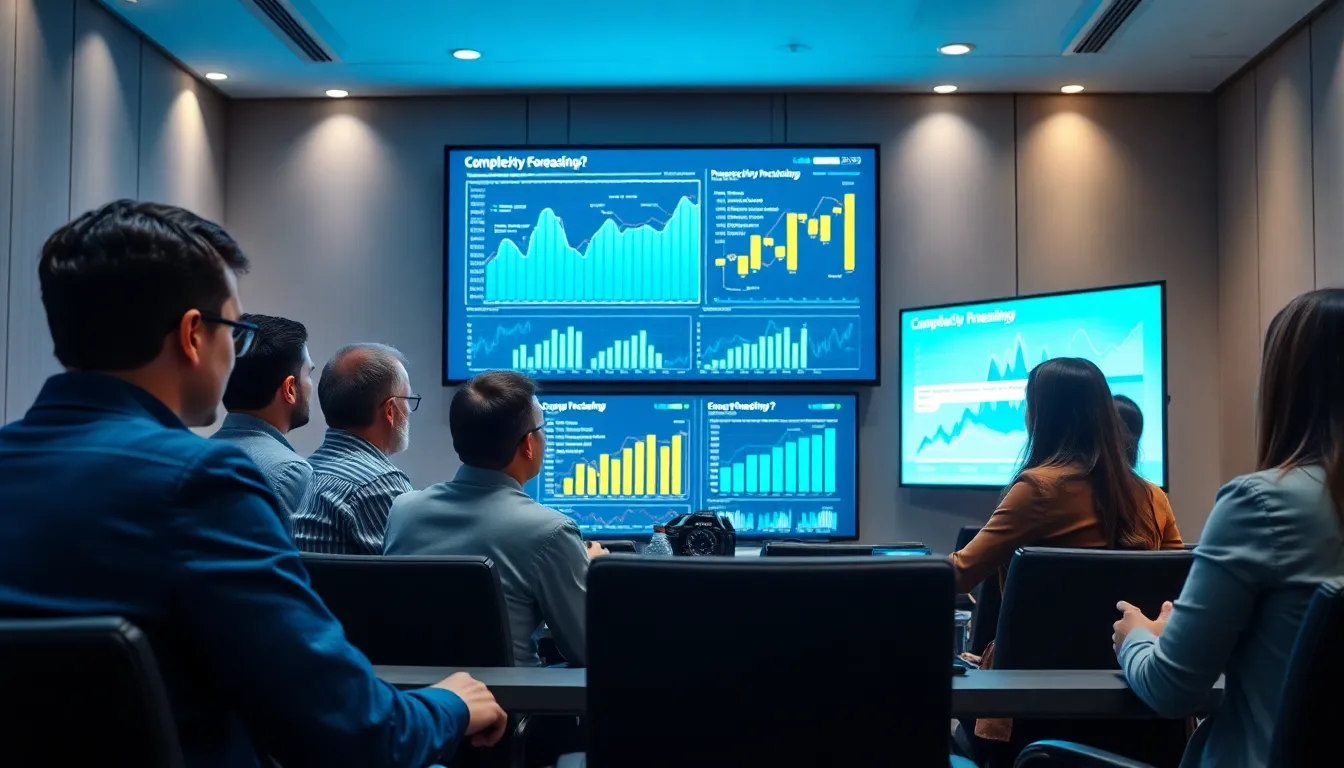In a world where change is the only constant, predicting the unpredictable might feel like trying to catch smoke with your bare hands. Enter complexity forecasting—a game-changer for businesses navigating the chaotic seas of modern markets. It’s not just about reading the tea leaves or consulting your favorite crystal ball; this approach combines data science with a dash of intuition to anticipate future trends and challenges.
Table of Contents
ToggleOverview of Complexity Forecasting
Complexity forecasting plays a critical role in helping businesses navigate unpredictable markets. This method combines data science with intuitive insights to provide more accurate predictions of future trends and challenges. Organizations leverage complexity forecasting to analyze intricate patterns within large datasets.
It integrates various factors, including market behavior, economic indicators, and consumer trends, allowing firms to anticipate shifts. By understanding these connections, companies can tailor their strategies more precisely to address potential disruptions. Furthermore, businesses that utilize this forecasting method often gain a competitive edge in their respective industries.
Real-time data collection serves as a foundation for effective complexity forecasting. Gathering information from multiple sources enables firms to react quickly to changes in market dynamics. Advanced algorithms and predictive analytics identify correlations and anomalies within the data, enhancing the decision-making process.
Moreover, complexity forecasting emphasizes the balance between quantitative data and qualitative insights. Relying solely on historical data may limit foresight, while incorporating diverse perspectives adds depth to predictions. Organizations that embrace this holistic approach often foster innovation and adaptability within their teams.
Complexity forecasting empowers businesses to transform uncertainty into actionable intelligence. This approach not only refines forecasting accuracy but also enhances strategic planning, ensuring resilience in a constantly evolving landscape.
Importance of Complexity Forecasting

Complexity forecasting serves as a crucial strategy for businesses navigating today’s unpredictable markets. Organizations leverage this method to gain insights into future trends and challenges.
Applications in Various Fields
Complexity forecasting finds application across industries like finance, healthcare, and supply chain management. In finance, firms analyze market volatility and suggest investment strategies. Healthcare organizations utilize this forecasting to optimize resource allocation and improve patient outcomes. Supply chain sectors rely on data trends to anticipate demand fluctuations, ensuring inventory management aligns with consumer needs.
Benefits of Effective Forecasting
Effective complexity forecasting yields numerous advantages for organizations. Increased accuracy in predicting market trends leads to better strategic planning. Enhanced decision-making capabilities stem from utilizing real-time data alongside historical insights. Companies often experience improved customer satisfaction through tailored products and services. Ultimately, businesses that excel in complexity forecasting maintain a competitive edge, adapt to change more swiftly, and respond to market demands efficiently.
Techniques in Complexity Forecasting
Techniques in complexity forecasting encompass a range of quantitative and qualitative methods. These approaches enable organizations to analyze complex data and derive meaningful insights to enhance decision-making.
Quantitative Methods
Quantitative methods leverage numerical data to identify trends and patterns. Statistical models, such as regression analysis and time series forecasting, play significant roles in these methods. Organizations frequently employ machine learning algorithms to analyze large datasets and improve accuracy. By transforming vast amounts of data into actionable insights, these techniques help predict future market behavior. Moreover, simulations often accompany quantitative analysis to assess various scenarios and outcomes, making the forecasting process more robust and informative.
Qualitative Methods
Qualitative methods complement quantitative approaches by incorporating human insights and intuition. Expert opinions and focus groups provide valuable context to data, allowing firms to understand underlying trends better. Organizations often utilize scenario planning and Delphi techniques for deeper exploration of potential future events. These methods encourage collaboration among stakeholders, enriching the decision-making process. Incorporating qualitative insights into forecasts helps businesses stay attuned to emerging disruptions and shifts in consumer preferences.
Challenges in Complexity Forecasting
Complexity forecasting presents several challenges that can impact its accuracy and effectiveness.
Data Limitations
Data limitations pose significant obstacles in complexity forecasting. Incomplete datasets hinder the ability to analyze trends accurately. Poor data quality affects predictions, leading to potential misinterpretations of market behavior. Missing key economic indicators can result in overlooked insights. Organizations often struggle with data integration from various sources, which complicates comprehensive analysis. Extracting relevant information from unstructured data demands considerable effort, making quality analysis challenging. Consequently, businesses must invest in refining their data collection processes to enhance forecasting accuracy.
Model Uncertainties
Model uncertainties create complications in complexity forecasting. Every predictive model carries inherent assumptions that can skew results. Variability in algorithm performance across different scenarios can lead to inconsistent outcomes. Calibration issues arise when models fail to adapt to changing market conditions, resulting in unreliable predictions. Overfitting occurs when models become too tailored to historical data, limiting their applicability to future situations. Additionally, interactions among various variables often exist in unpredictable ways, complicating modeling efforts. Businesses should focus on continuously validating and updating their models to mitigate these uncertainties.
Future Trends in Complexity Forecasting
Emerging trends in complexity forecasting point towards increased reliance on artificial intelligence. AI technologies enhance predictive analytics by processing vast datasets more efficiently. Additionally, organizations are adopting real-time analytics tools that provide immediate insights into shifting market dynamics, allowing for quicker strategic adjustments.
The integration of big data will become more pronounced in complexity forecasting. Enhanced data sources, such as IoT devices and social media analytics, will provide richer information layers. These sources enrich the understanding of consumer behavior, creating opportunities for more nuanced forecasts.
An emphasis on scenario-based forecasting is also notable. Businesses increasingly recognize the value of preparing for multiple potential futures rather than relying on single predictions. Scenario planning enables firms to navigate uncertainty by visualizing various possible outcomes and their implications.
Collaboration will take center stage as companies seek to leverage collective expertise. Stakeholder engagement through workshops and brainstorming sessions fosters innovation in forecasting methods. Organizations that prioritize teamwork and knowledge sharing often experience improved forecasting accuracy.
Regulatory landscapes will influence complexity forecasting methodologies. Firms must adapt to changing compliance requirements while maintaining robust data practices. Emphasizing transparency and ethical data usage aligns forecasting efforts with regulatory expectations.
The advent of quantum computing holds promise for future advancements in complexity forecasting. This technology will potentially revolutionize data processing capabilities, allowing for more complex models and increased accuracy in predictions.
The future of complexity forecasting hinges on leveraging advanced technologies, fostering collaboration, embracing scenario planning, and aligning with regulatory frameworks. Organizations that adopt these approaches are likely to achieve more reliable forecasts and better adapt to market volatility.
Complexity forecasting stands as a transformative approach for businesses seeking to thrive amid uncertainty. By blending data science with human insights organizations can navigate intricate market dynamics more effectively. The integration of advanced technologies and real-time analytics will further enhance predictive capabilities allowing firms to adapt swiftly to emerging trends.
As the landscape continues to evolve embracing complexity forecasting will not only refine decision-making but also strengthen resilience against potential disruptions. Companies that invest in this strategic tool are better equipped to anticipate market shifts and meet consumer demands. Ultimately this method empowers organizations to turn unpredictability into opportunities for growth and innovation.






